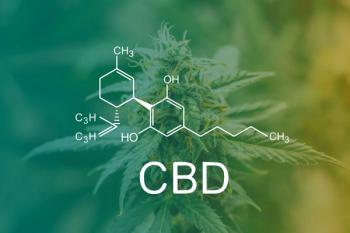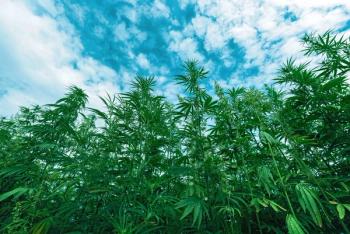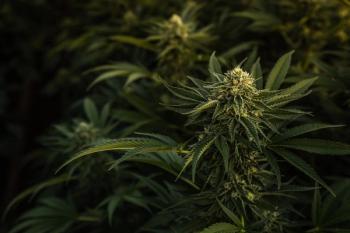
Cannabis Science and Technology
- March 2023
- Volume 6
- Issue 2
- Pages: 12-15
The Transformation of Cannabis Terpenes from Harvest to Shelf

In this article, we explore the difference in chemical profile between fresh and dry cannabis flower and why manufacturers may choose to extract frozen or dry cannabis.
Cannabis is known for its distinct aroma. This aroma is due to the terpene profile during the flowering stage of the growth cycle. The aroma is more complex and amplified after the product has been dried and cured. The terpene profile of the plant is vastly different when it is freshly harvested as opposed to dried and cured. Manufacturers of cannabis concentrate and vape products have brought a new terpene profile to market by extracting cannabis that has been freshly harvested and frozen. In this article, we explore the difference in chemical profile between fresh and dry cannabis flower and why manufacturers may choose to extract frozen or dry cannabis.
Terpenes and terpenoids are aromatic compounds in the essential oils of plants, including cannabis. While many cannabis plants have a characteristic aroma, there is a wide array of cannabis phenotypes that produce a complex variety of terpene profiles. These unique aromatic profiles produce cannabis that smells like skunks, pineapples, blueberries, and many other familiar things. The cannabis plant can produce hundreds of terpenes based on genetics and environmental factors.
Cannabis plants produce glandular trichomes, which are bulbous plant appendages. Trichomes are found in only 30% of all plants. Terpenes and terpenoids are produced in the glandular trichomes of the cannabis plant. These glandular trichomes produce and house many metabolites of the cannabis plant, which include cannabinoids, terpenoids, and flavonoids. Three types of trichomes have been identified on the cannabis plant: sessile, bulbous, and stalked (Figure 1).
These three trichomes have different structural characteristics. However, they are also located in different parts of the plant and house different compounds. Stalked trichomes have a large head and house high concentrations of cannabinoids and monoterpenes. They are mainly found on the flowers of the female plants. Sessile trichomes are glandular with a short stalk and are mainly found on the outer leaves of the flower, known as sugar leaves, and produce both cannabinoids and sesquiterpenes. However, sessile trichomes produce much lower concentrations of cannabinoids and much higher concentrations of sesquiterpenes. Bulbous trichomes are the smallest of the three trichomes. They are more often located on the stalk and stems of the plant, help the plant maintain moisture, and protect the plant from the sun. When cannabis is harvested, the flowers are selected to obtain the highest concentrations of cannabinoids and terpenes.
The terpene profile of any given cannabis plant is dependent on many variables including genetics, environment, and grow method. However, when the plant has been freshly harvested the concentration of monoterpenes is higher than after a drying and curing process (2,3). The most common monoterpenes found in cannabis are beta-myrcene, limonene, alpha-pinene, linalool, and terpinolene. The most common sesquiterpenes found in cannabis are caryophyllene and humulene. The stalked trichomes exist in much higher concentrations than sessile trichomes, which leads to the conclusion that in cannabis there will be higher concentrations of monoterpenes. Terpenes and terpenoids are valuable components of the cannabis chemical profile. They not only give the plant its aroma, but also affect the physiological effects of cannabis.
Historically, the main method of consumption for cannabis flower has been smoking. The flower is dried and cured prior to consumption to lower the water content of the plant, increase the concentration of the desired compounds, and make it possible to smoke. In this drying process, depending on the storage conditions, the terpene profile will change. When done properly, the drying process will increase the total concentration of terpenes and develop a richer profile. When done improperly, all terpenes can be lost, and cannabinoids can degrade (2).
The curing process involves drying the product in a controlled environment and cycling oxygen in the curing environment. During this curing process, the concentration and composition of terpenes can change as a result of several factors, including:
- Evaporation: As the flower dries, some terpenes may evaporate and dissipate, leading to a reduction in their overall concentration.
- Decomposition:Over time, some terpenes may undergo chemical reactions or degradation, altering their molecular structure, and affecting their aroma and flavor.
- Conversion: Some terpenes can be converted into other compounds through natural processes such as oxidation or enzymatic reactions.
- Development: As the flower continues to age, new terpenes may be produced or existing terpenes may increase in concentration, leading to changes in the overall terpene profile.
The composition of terpenes in the cured flower will be vastly different from that of the fresh flower.
Cannabis flower has become a commodity in most mature adult-use markets. This is because of an excess in production of cannabis biomass. With this much biomass available, extraction operators and cultivators are looking for ways to preserve and store large quantities of biomass as well as convert it into a wider variety of products that are stable.
Most extracts have come from cured cannabis biomass; however, a shift has occurred. Many extractors, especially those using hydrocarbon solvents or solventless processes, have begun using freshly harvested cannabis in extractions. As a result, these extracts offer a completely different terpene profile from extracts produced with cured biomass. The cannabinoid profile of freshly harvested biomass will also be different from that of cured cannabis. Enzymes in the cannabis plant continue to convert cannabinoids and terpenoids in the plant, even after harvest.
This category of extracts has been named “live resin” and has taken the market by storm. To preserve the freshly harvested cannabis, the product must be frozen, or the product is at risk of developing mold. Instead of dedicating time and space to the drying and curing process, cultivation and extraction companies can simply freeze the biomass. This has created a streamlined storage process for large quantities of biomass. The downside is that freezers are not an efficient use of space and do require constant electricity. Alternatively, some companies are utilizing freeze drying technology to dry the cannabis while mitigating terpene loss.
Based on the growth of this segment of the market, it is clear that consumers are finding live resin to be unique and enjoyable. The main difference is the terpene profile, as live resin products will have more monoterpenes than extracts produced from cured cannabis. In the midst of the exponential growth of this product segment, cannabis companies have taken advantage of the lack of standardized taxonomy in the industry (4). In an effort to create a foundational standard for manufacturing terms in cannabis, the National Cannabis Industry Association (NCIA) produced a Glossary of Commercial Manufacturing Terms (5). In this glossary, the definition is (5): “Live Resin (n.): A cannabis extract product produced from plant material that was harvested and stored such as to preserve the chemical profile of the living plant, typically by freezing or freeze drying the material shortly
after harvesting.”
There are countless companies using the term “live resin” on products that are not produced from fresh frozen cannabis. Many products labeled “live resin” are simply distillate infused with cannabis derived terpenes from fresh or cured plant material, leaving out the entire cannabinoid profile of the freshly harvested biomass. This exposes a serious flaw in the cannabis industry as consumers can purchase products that are perceived to be one thing but are not. It will be interesting to watch this segment and uncover why consumers are truly drawn to these products.
References
- Sommano, S.R.; Chittasupho, C.; Ruksiriwanich, W.; Jantrawut, P.; The Cannabis Terpenes. Molecules. December 8, 2020; 25 (24). DOI: 10.3390/molecules25245792. PMID: 33302574; PMCID: PMC7763918.
- Bueno, J.; Leuer, E.; Kearney, M.; The preservation and augmentation of volatile terpenes in cannabis inflorescence. J Cannabis Res, 2020, 2, 27. DOI:
https://doi.org/10.1186/s42238-020-00035-z - Wietstock, C. Researchers Reveal How Curing Cannabis Affects Terpene Levels
https://www.ganjapreneur.com/researchers-reveal-how-curing-cannabis-affects-terpene-levels/#:~:text=After%20one%20week%20of%20drying,and%20Beta%2DCaryophyllene%20were%20increased . - Luebke, D. What are live resin vapes? why are live resin vapes popular?
https://www.heylocannabis.com/post/what-are-live-resin-vapes-and-why-are-they-popular . - The National Cannabis Industry Association Cannabis Manufacturing Committee. Glossary of Commercial Manufacturing Terms
https://drive.google.com/file/d/1rogqYBmQpe3VlqBchfsJ0iysjfbSq5bn/view .
About the Columnist
Lo Friesen is the founder, CEO, and Chief Extractor of Heylo. With a background in chemistry and clinical research, Lo was inspired to explore cannabis as a medicine and to enter the emerging industry. She joined Eden Labs, a leading CO2 extraction equipment manufacturer to support and expand a Research and Development department. There she managed the development of their latest and greatest CO2 extraction system. In 2017, after working with Eden Labs and another cannabis processor, Lo launched Heylo with a mission to help people get more out of life with cannabis.
How to Cite this Article:
Friesen, L., The Transformation of Cannabis Terpenes from Harvest to Shelf, Cannabis Science and Technology, 2023, 6(2), 12-15.
Articles in this issue
almost 3 years ago
Cannabis Extraction Facility Setup 101Newsletter
Unlock the latest breakthroughs in cannabis science—subscribe now to get expert insights, research, and industry updates delivered to your inbox.




